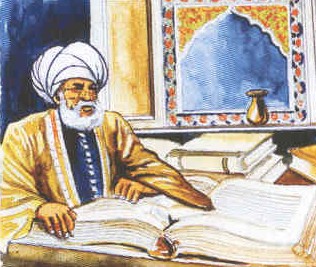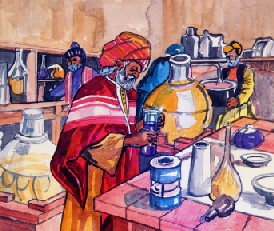|
Abu
Musa Jabir Ibn Hayyan, in Latin Geber, was one of the
most notable Arab alchemists. He was born in 721 CE in
Tus (present day Iran) and died around 815in Kufah,
Iraq. He is credited with the discovery and description
of many substances and processes — such as the
hydrochloric and nitric acid, distillation, and
crystallization — that have become the foundation of
today's chemistry and chemical engineering.
Jabir's experimental ideas
paved the way for now commonly known classification of
substances as metals, nonmetals and volatile substances.
He discussed three distinct types of substances based on
their properties:
a) spirits, i.e., these
that vaporize on heating, like camphor, arsenic and
ammonium chloride.
b) metals, e.g., gold,
silver, lead, copper, iron.
c)
compounds that can be converted into powders.
Contributions to Chemistry
Jabir
wrote more than one hundred treatises on various
subjects, of which 22 are about alchemy. Firmly grounded
on experimental observation, his books systematized the
knowledge about the fundamental chemical processes of
the alchemists — such as crystallization, distillation,
calcination, sublimation, thus making a great step in
the evolution of chemistry from an occultist art to a
scientific discipline. In particular, Jabir emphasized
that definite quantities of various substances are
involved in a chemical reaction, thus anticipating by
almost a thousand years the principles of quantitative
chemistry and the law of constant proportions.
Jabir is also credited with the invention and
development of several chemical instruments that are
still used today, such as the alembic, which made
distillation easy, safe, and efficient. By distilling
various salts together with sulfuric acid, Jabir
discovered hydrochloric acid, from salt, and nitric
acid, from saltpeter.
Besides its obvious
applications to gold extraction and purification, this
discovery would fuel the dreams and despair of
alchemists for the next thousand years. He is also
credited with the discovery of citric acid.

Ibn Hayyan is
famous for writing more than one hundred monumental
treatises, of which twenty-two deal with chemistry and
alchemy. He introduced experimental investigation into
alchemy (derived from Arabic word al-Kimiya), creating
the momentum for the modern Chemistry. Jabir emphasized
experimentation and development of methods to achieve
reproducibility in his work. He devoted his effort to
the development of basic chemical methods and the study
of various mechanisms of chemical reactions and thus
helped evolve chemistry as a science from the legends of
alchemy. Jabir emphasized that definite quantities of
various substances are involved in a chemical reaction.
Therefore, it can be said that he paved the way for the
law of constant proportions.
Jabir applied his chemical knowledge to the improvement
of many manufacturing processes, such as the making of
steel, corrosion prevention, gold lettering, cloth
dyeing and waterproofing, leather tanning, and the
chemical analysis of pigments and other substances. He
developed the use of manganese dioxide in glassmaking,
to counteract the green tinge produced by iron — a
process that is still used to this day. Jabir was a
pioneer in the development of a number of applied
chemical processes. His contributions include
preparation of various metals, varnishing of waterproof
cloth, identification of paints and greases. In
addition, he developed aqua regia to dissolve gold.
He noted that boiling Alcohol released a flammable
vapor, thus paving the way to Al-Razi's discovery of
ethanol.
His contribution of fundamental importance to chemistry
includes perfection of scientific techniques such as
crystallization, distillation, calcination, sublimation
and evaporation and development of several instruments
for conducting these experiments. Jabir's major
practical achievement was the discovery of minerals and
acids, which he prepared for the first time in his
alembic (Anbique). His invention of the alembic made the
distillation process easy and systematic. Among his
various breakthroughs is the preparation of nitric,
hydrochloric, citric and tartaric acids. Jabir's
emphasis on systematic experimentation is outstanding.
It is on the basis of such works that he is regarded as
the father of modern Chemistry. In the words of Max
Mayerhaff, the development of chemistry in Europe can be
traced directly to Jabir.
In the Middle Ages, Jabir's treatises on chemistry were
translated into Latin and became standard texts for
European alchemists. These include the Kitab al-Kimya
(titled "Book of the Composition of Alchemy" in Europe),
translated by Robert of Chester (1144) and the Kitab
al-Sab'een by Gerard of Cremona (before 1187).
Berthelot translated some his books known by the titles
"Book of Kingdom", "Book of the Balances," "Book of
Eastern Mercury," and it is obvious that he did not use
correct titles for Jabir's books. It became soon obvious
that this so-called translator used all means to
belittle Jabir’s achievements and attribute them to
others European Scientists. Several technical terms
introduced by Jabir, such as alkali, have found their
way into various European languages and have become part
of scientific vocabulary.
Jabir also made important
contributions to medicine, astronomy, and other
sciences. Unfortunately, only a few of his books have
been edited and published, and fewer still are available
in translation.
To Aristotelian physics, Jabir added the four properties
of hotness, coldness, dryness, and moistness. Each
Aristotelian element was characterized by these
qualities: fire was both hot and dry, earth cold and
dry, water cold and moist, and air hot and moist. In
metals two of these qualities were interior and two were
exterior. For example, lead was cold and dry and gold
was hot and moist. Thus, Jabir theorized, by rearranging
the qualities of one metal, a different metal would
result. This theory appears to have originated the
search for al-iksir, the elusive elixir that
would make this transformation possible — which in
European alchemy became known as the philosopher's
stone.
In his treatise on
the silvering of copper and iron, and in what has become
known as “The Discovery of secrets”, Jabir wrote: “You
must value and not contradict what is written; remember
well how to manage without diminishing or augmenting,
take as much as you wish of the stone mixed with its
mixture and grind it with some water, mixed with
copperas and Sal ammoniac until it becomes black. Then
put it very near a very slight heat until it smells like
semen. When it has that smell take it away and wash it
slowly with some clear water, and then roast it gently
until you notice a visible vapour. In this way its water
will be driven off, and the stone itself will become
light, without losing its essence. Take it off and dip
it again into water, powdering it under water, and roast
it as before. Its blackness begins to diminish. Take off
the stone when it is dry and its water absorbed. Grind
it well in some clear water and roast it again. It
begins to be green, and then this blackness will
disappear. When you see the stone beginning to turn
green, be sure you are in the right path. Move it then
when it becomes quite green and has the appearance of
verdigris. This will show that the process is right, and
the stone has lost its Sal ammoniac which would have
corrupted it. After powdering it in some water, put it
into a vessel well luted with plaster, place it on a
gentle fire, and distil off all its water. Be patient
and do not be in a hurry to increase the fire which will
corrupt it; for you will repent, and your Itallic
repentance will never be of avail. When you distil off
all its water, take it off, and powder it in the same
distilled water. Then return it to the vessel, and renew
the distillation.

I recommend you to distil it
700 times like the rods of myrtle, and Indian cane. I
have not explained this hint in any one of my books, but
in this only. I have told you the opinion of
philosophers without diminishing or increase, and have
not concealed anything from you. When the stone becomes
green we call it myrtle, and when it returns to yellow,
we give it the name of Indian cane. You must know that
it becomes gradually black from the first to the last.
It remains quite black from five to ten roastings; then
it slowly becomes green, and has the colour completely
in 50 or 70 roastings. This is the end. If the stone
acquires these qualities, there will be no doubt of its
goodness. Its yellow colour begins bye-and-bye to
disappear and the stone will completely lose its
clearness in 70 roastings. Then the stone will have the
same degree as the sun, and similar coloured rays. It
will burn, and become ashes. They are the same ashes
mentioned in the books of philosophers. If you continue
the same process, the ashes will become quite white.
This is the fourth sign, which is the sign of
perfection. Therefore you must continue to proceed as
before without diminishing or increase. Then it is
necessary to augment the fire just a little, and do not
fear the corruption. If you continue to distil it you
must return the distilled water on it, and in every
distillation the water diminishes; therefore it is
necessary, every ten distillations, to add some clear
water to the distilled water with which you pulverize
it. If the stone begins to turn white, you must continue
the same process until it turns very white. This will be
from 500 distillations. If the fire diminish, and the
operator be clever, knowing well the quantity of fire,
from 450 distillations (the total is 900 distillations),
the stone, you may be sure, will have a complete and
real whiteness. In this state you may operate for giving
copper and iron a coating of silver. You can also
operate on melted crystal, and pearls, and many other
minerals.”
|
